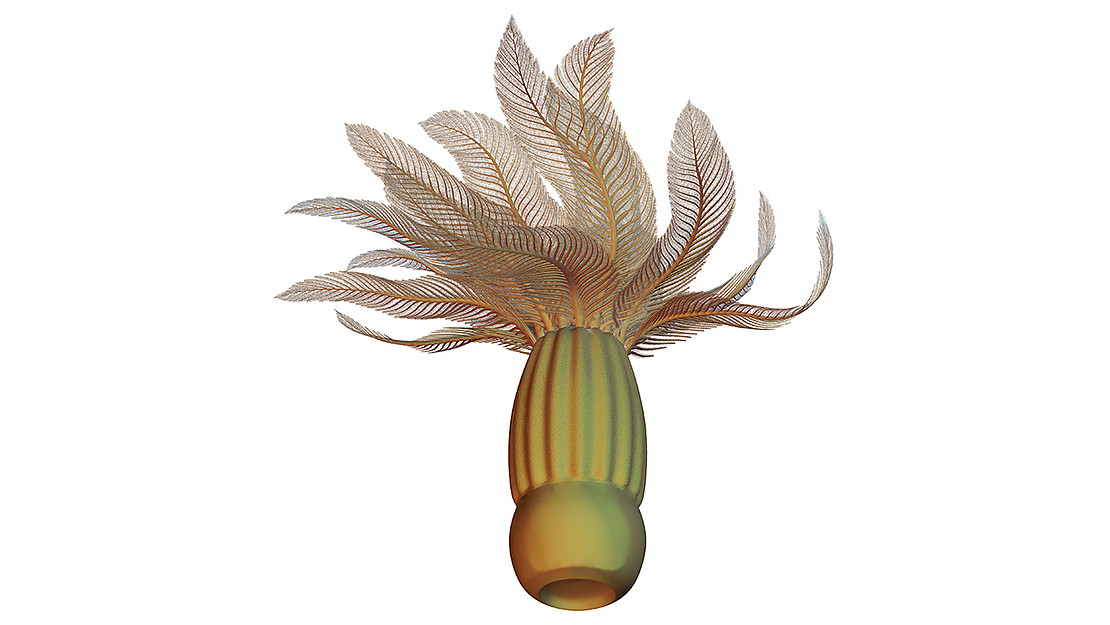This page contains automatically translated content.
Kasseler Gastwissenschaftler löst Geheimnis um kambrische Fossilien
 Image: Huanzhen Li & Qiang Ou
Image: Huanzhen Li & Qiang OuNach Erkenntnissen von Ou, Mayer und weiteren Ko-Autoren gehört das vor etwa 520 Millionen Jahren lebende Ur-Wesen †Xianguangia sinica,andersals bislang angenommen,zur Stammgruppe der Nesseltiere, zu denen heute etwa auch Quallen, Korallen und Seeanemonen zählen. Das Tier war circa fünf Zentimeter groß, ähnelte einem Polypen, besaß aber eine zusätzliche Leibeshöhle, die offenbar als Hydroskelett diente, sowie eine Ankervorrichtung an der Körperbasis. Charakteristisch waren federartige Tentakel, die mit zahlreichen Wimpern besetzt waren und wohl der Nahrungsaufnahme dienten. „Der Federpolyp“, wie die Wissenschaftler †X. sinica nun umgangssprachlich getauft haben, „warein sogenannter Suspensionsfresser“, stellt Mayer fest. Das heißt, dass es organisches Material durch Wimpernschlag aus dem Wasser filterte und so in Richtung Mund beförderte. Bislang hatte man nämlich angenommen, dass sich †X. sinica, wie die meisten rezenten Nesseltiere, mithilfe der Cnidozyten (= Nesselzellen) räuberisch ernährte.
Die Wissenschaftler konnten auch die bis dato widersprüchliche Einordnung der Fossilien †Chengjiangopenna wangii (einer vermeintlichen Seefeder) und †Galeaplumosus abilus (des angeblich ältesten Hemichordaten) eindeutigklären: Demnach handelt es sich bei diesen Fossilien lediglich um Körperfragmente von †X. sinica, die zuvor fälschlicherweise als zwei selbstständige Arten identifiziert und beschrieben wurden.
Die detaillierte Rekonstruktion des Körperbaus von †X. sinicawurde durch 85 neue, zum Teil ausgesprochen gut erhaltene Exemplare aus der chinesischen Chengjiang-Lagerstätte ermöglicht. Ou, Mayer und Kollegen untersuchten diese u.a. mithilfe der Licht- und Rasterelektronenmikroskopie (REM) sowie der energiedispersiven Röntgenspektroskopie (EDX). Anschließend führten die Wissenschaftler zudem phylogenetische Analysen durch, um die fossile Art im Stammbaum der Tiere einzuordnen. Die Ergebnisse deuten darauf hin, dass die Vielfalt der Körperformen und Ernährungsweisen der urzeitlichen Nesseltiere größer war als bisher angenommen.
Entscheidende Teile dieser Studie wurden an der Universität Kassel durchgeführt, wo Dr. Qiang Ou (40) seit Juli 2016 als Stipendiat der Alexander von Humboldt-Stiftung am Fachgebiet Zoologie forscht.
In der Chengjiang-Lagerstätte sind in den letzten Jahrzehnten zahlreiche bisher unbekannte Fossilien entdeckt worden, die nun eine neue Dimension für unser Verständnis der Evolution der Artenvielfalt im kambrischen Zeitalter eröffnen. Viele dieser Fossilien sind jedoch noch nicht vollständig und eindeutig ausgewertet. Unter dem Begriff kambrische Explosion versteht man das massive Auftreten neuer Arten im kambrischen Zeitalter vor etwa 530 Millionen Jahren.
Die Ergebnisse sind jetzt im angesehenen Journal „Proceedings of the National Academy of Sciences of the United States of America“ (PNAS) veröffentlicht worden: http://www.pnas.org/content/early/2017/07/26/1701650114.abstract
Rekonstruktion des Federpolyps †Xianguangia sinica, eines ausgestorbenen Stammlinienvertreters der Nesseltiere (Quallen, Korallen & Co.). Copyright: Huanzhen Li & Qiang Ou: http://www.uni-kassel.de/uni/fileadmin/datas/uni/presse/anhaenge/2017/Fossil_Photo_Qiang_Ou_Huanzhen_Li.jpg
Kontakt:
Prof. Dr. Georg Mayer
Universität Kassel
Fachgebiet Zoologie
Tel: +49 (0)561 804-4805
E-Mail: georg.mayer[at]uni-kassel[dot]de